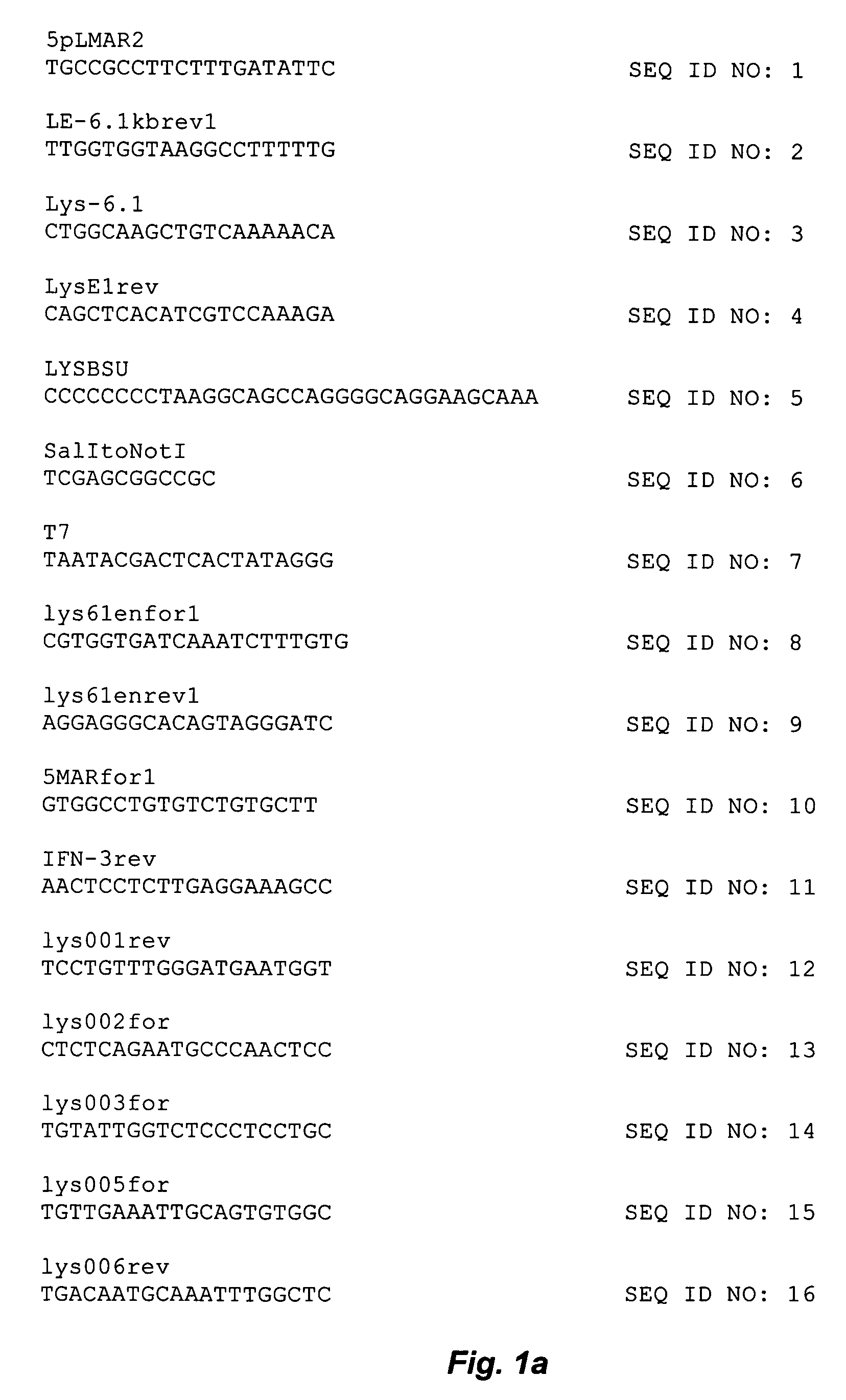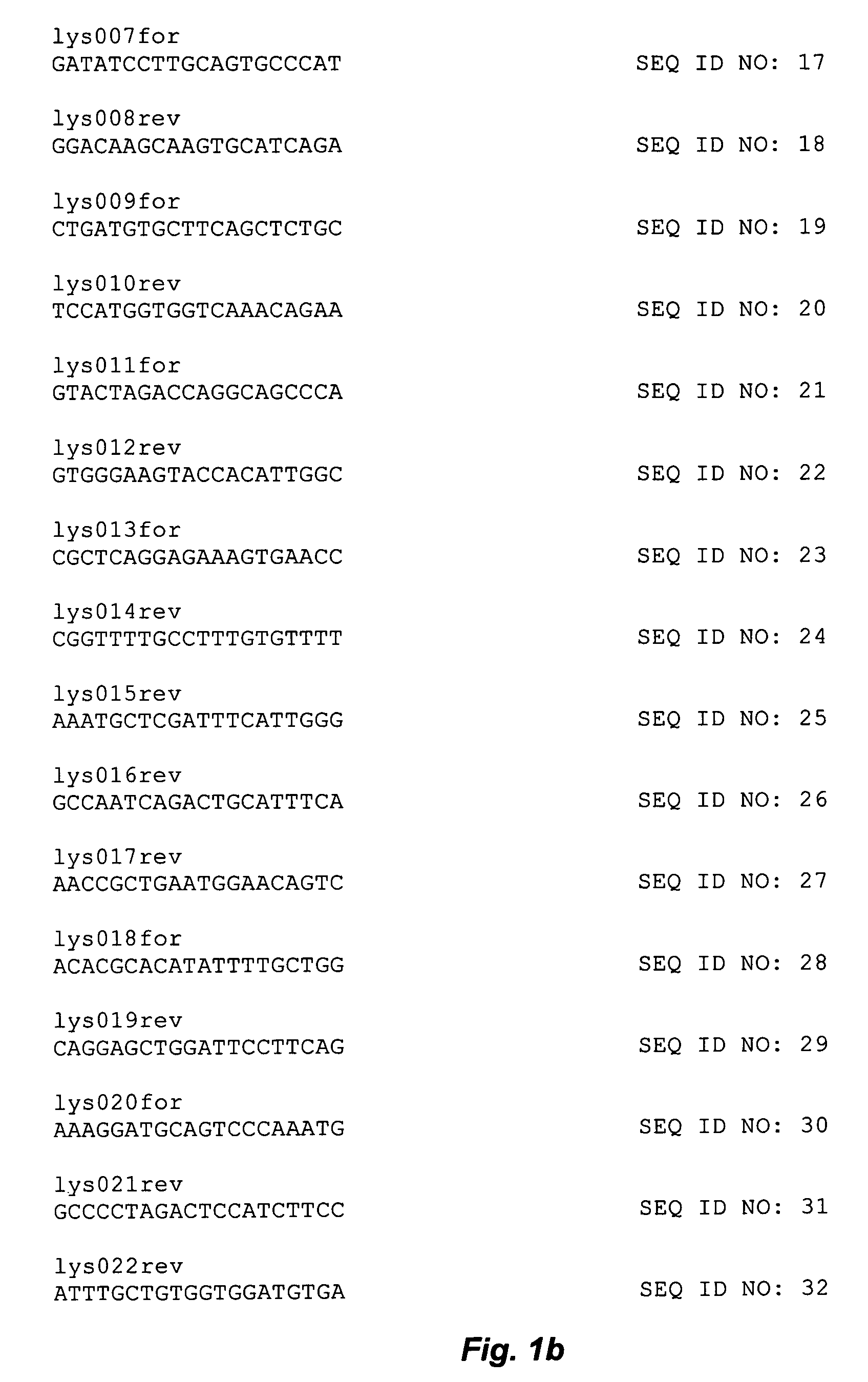Recombinant promoters in avian cells
a technology of promoters and avian cells, applied in the field of identification of an avian lysozyme gene expression control region, can solve the problems of limited success and attendant costs of maintaining individual animals, and achieve the effect of reducing the positional variation of transgenic avians
- Summary
- Abstract
- Description
- Claims
- Application Information
AI Technical Summary
Benefits of technology
Problems solved by technology
Method used
Image
Examples
example 1
Construction of Lysozyme Promoter Plasmids
[0160]The chicken lysozyme gene expression control region was isolated by PCR amplification. Ligation and reamplification of the fragments thereby obtained yielded a contiguous nucleic acid construct comprising the chicken lysozyme gene expression control region operably linked to a nucleic acid sequence optimized for codon usage in the chicken (SEQ ID NO: 66) and encoding a human interferon α2b polypeptide optimized for expression in an avian cell.
[0161]White Leghorn Chicken (Gallus gallus) genomic DNA was PCR amplified using the primers 5pLMAR2 (SEQ ID NO: 1) (see FIG. 1) and LE-6.1 kbrev1 (SEQ ID NO: 2) in a first reaction, and Lys-6.1 (SEQ ID NO: 3) and LysE1rev (SEQ ID NO: 4) as primers in a second reaction. PCR cycling steps were: denaturation at 94° C. for 1 minute; annealing at 60° C. for 1 minute; extension at 72° C. for 6 minutes, for 30 cycles using TAQ PLUS PRECISION™ DNA polymerase (Stratagene, LaJolla, Calif.). The PCR products...
example 2
Construction of Plasmids which Contain the 3′ Lysozyme Domain
[0164]The plasmid pAVIJCR-A 115.93.1.2 was restriction digested with FseI and blunt-ended with T4 DNA polymerase. The linearized, blunt-ended pAVIJCR-A115.93.1.2 plasmid was then digested with XhoI restriction enzyme, followed by treatment with alkaline phosphatase. The resulting 15.4 kb DNA band containing the lysozyme 5′ matrix attachment region (MAR) and −12.0 kb lysozyme promoter driving expression of a human interferon was gel purified by electroelution.
[0165]The plasmid pIIIilys was restriction digested with MluI, then blunt-ended with the Klenow fragment of DNA polymerase. The linearized, blunt-ended pIIIilys plasmid was digested with XhoI restriction enzyme and the resulting 6 kb band containing the 3′ lysozyme domain from exon 3 to the 3′ end of the 3′ MAR was gel purified by electroelution. The 15.4 kb band from pAVIJCR-A115.93.1.2 and the 6 kb band from pIIIilys were ligated with T4 DNA ligase and transformed in...
example 3
Sequencing Reactions
[0166]Plasmid DNA (pAVIJCR-A115.93.1.2) produced as described in Example 1 was purified with QIAGEN™ columns (Qiagen, Valencia, Calif.). Sequencing reactions were performed according to the Applied Biosystems (Foster City, Calif.) protocol for BIGDYE™ Terminators, version 2.0, using an ABI 373 Stretch sequencer. Sequencing primers used are listed in FIG. 1, and a schematic diagram illustrating the sequencing reactions using the different primers is shown in FIG. 2. Sequence data was analyzed with SEQUENCHER™ software, version 4.0 (Gene Codes Corp., Ann Arbor, Mich.).
PUM
| Property | Measurement | Unit |
|---|---|---|
| temperature | aaaaa | aaaaa |
| temperature | aaaaa | aaaaa |
| pH | aaaaa | aaaaa |
Abstract
Description
Claims
Application Information
 Login to View More
Login to View More - R&D
- Intellectual Property
- Life Sciences
- Materials
- Tech Scout
- Unparalleled Data Quality
- Higher Quality Content
- 60% Fewer Hallucinations
Browse by: Latest US Patents, China's latest patents, Technical Efficacy Thesaurus, Application Domain, Technology Topic, Popular Technical Reports.
© 2025 PatSnap. All rights reserved.Legal|Privacy policy|Modern Slavery Act Transparency Statement|Sitemap|About US| Contact US: help@patsnap.com



